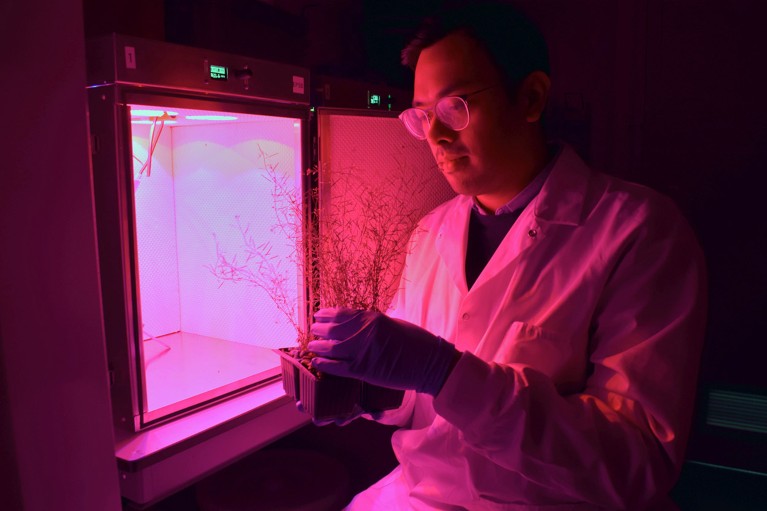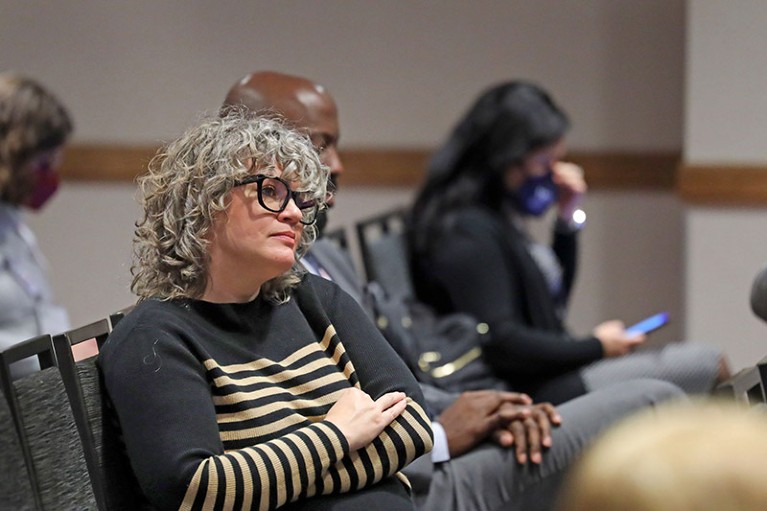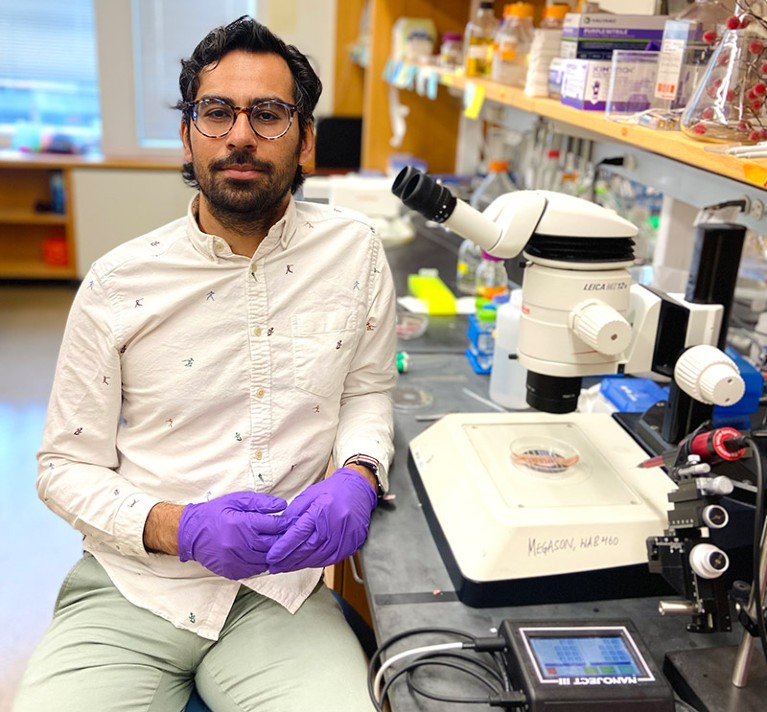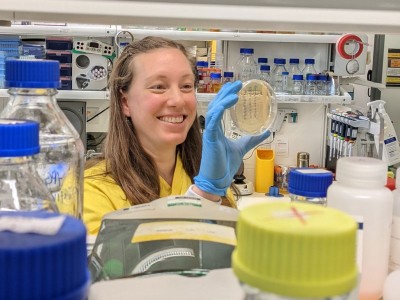To diversify the scientific workforce, postdoc recruitment needs a rethink

[ad_1]

Devang Mehta was hired through an ‘open’ faculty-recruitment programme.Credit: Kaat Hebbelinck
It’s been known for nearly half a century that the ‘chilly climate’ of science higher education can make some students of colour feel unwelcome1. Since then, the shortage of people from minority groups in science, technology, engineering, and mathematics (STEM) fields has captured public attention and research interest. Diversity initiatives seek to identify and equip under-represented students, and there is growing recognition that the academic environment itself needs reform.
Figures suggest there has been some progress. Between 2006 and 2016, the number of African Americans and Latinos who obtained doctoral degrees in the United States rose by 31% and 54% respectively, according to data from the 2018 US National Science Foundation (NSF) Survey of Earned Doctorates.
Yet, despite these gains, decades of focus and millions of research dollars have failed to produce meaningful change at the highest levels of academic achievement and influence — the professoriate. In the United States, the share of tenure-track or tenured faculty members from under-represented groups — Black, Latino, American Indian and Alaska Native — edged up just one percentage point (from 11% to 12%) between 2013 and 20192. In the United Kingdom, Black people make up 8% of the country’s science undergraduates but only 0.6% of science professors, according to a December 2022 Nature investigation (see go.nature.com/3nk3c5h).
Since 2020, both the global protests by the Black Lives Matter movement and time for reflection during COVID-19 pandemic lockdowns have helped to reprioritize and reinvigorate long-standing efforts to diversify science.
“People realized that this is the time to create a change,” recalls Mayank Chugh, who arrived in Boston, Massachusetts, to begin a systems biology postdoc at Harvard Medical School several months before the pandemic hit.
Researchers who analysed the biomedicine training pathway found that the greatest loss of people from under-represented minorities seems to occur at two points: during undergraduate education, and in the transition from postdoctoral fellowship to tenure-track faculty position3. The latter juncture is particularly challenging: postdocs work long hours for little pay, and those from marginalized backgrounds face extra hurdles because of undue bias in faculty hiring.
Career resources for postdoctoral researchers
Nature’s 2020 global survey of postdoctoral researchers revealed that more than half (53%) of the 7,670 respondents reported earning less than US$50,000 annually, and 61% typically worked at least 6 hours a week more than their contracted hours (see go.nature.com/45kjk2v). (Look out for the chance to take Nature’s 2023 global postdoc survey later this month.)
Efforts to alleviate these barriers focus on creating clearer processes for admission to postdoctoral positions, increasing the visibility of postdocs’ research, and involving a broader range of people on faculty hiring committees, including having applicants’ research plans evaluated by experts who are not part of the hiring department.
Current practices for STEM faculty recruitment are “designed around white men”, says Marybeth Gasman, education researcher at Rutgers University in New Brunswick, New Jersey, and author of a book on tackling racism in academic hiring, Doing the Right Thing (2022). “We have to figure out how to redesign [them].”
No standard path
Unlike undergraduate or graduate programmes, which have a structured admissions process, many postdoc positions are filled by an informal process, in some cases by word of mouth. A faculty member who is awarded a grant to hire a postdoc will typically say, “I need someone with this expertise, so I’m going to share that with my network and see if they have emerging students who might be interested,” says Jessica Bennett, assistant vice-president of STEM education at the Association of Public and Land-grant Universities in Washington DC.
Postdoctoral candidates will often express interest in an advertisement or post by sending an e-mail to the principal investigator (PI). It proceeds informally from there, says Chugh. If it seems like a good match and an initial chat goes well, the PI will invite the candidate to give a research talk and meet laboratory members before deciding whether to offer them the job.

The postdoc career stage can be key to career advancement, says Jessica Bennett.Credit: Josh Gold Photography
Given the lack of oversight and consistency for this crucial step of the pipeline, it’s hard to nail down trends in the hiring of minority postdoctoral candidates. “Who is applying? Where are they from? What are their stories like?” asks Chugh. This would help to inform processes and decision-making, but “we don’t have the data”, he says.
Those data would mainly come from individual PIs, says Chugh. “We want to see, for example, if a PI gets 100 applications, who are these applications from? Are there biases around who gets an interview? We just don’t know. Everything is at the discretion of the PI and their lab.”
Other complications arise from inconsistencies in how postdocs are categorized. Some institutions treat postdocs as lecturers or academic staff, whereas other places might consider them as more like a “student on steroids”, Bennett says. That makes it challenging to address the loss of under-represented minority trainees during the postdoc stage.
High stakes
Time spent as a postdoc is a crucial step for career advancement. It’s when a trainee transitions from working on problems outlined by the PI to thinking more independently — “developing new lines of research, establishing themselves in their field”, says Bennett. The stakes are high: in most STEM fields, the postdoc stage “is considered almost a requirement for hiring into the faculty position”, she says.
For institutions, postdocs serve another purpose — “quite frankly, getting inexpensive labour to work in labs”, says Gasman, who also serves as Rutgers’ associate dean for research in the Graduate School of Education.
Gasman also spent more than a decade co-directing a postdoc programme, funded by the US National Institutes of Health (NIH), that focused on giving postdocs teaching experience at institutions that serve large numbers of students from minority ethnic groups. She found that postdocs would, at times, come to her and “confide that they were being worked countless hours”, she says. Many were spending 80 or more hours a week doing lab research, while also mentoring PhD students and undergraduates, leaving few hours for family if they were married and had a child, Gasman says. It’s easy for postdocs to feel trapped.
A postdoc’s guide to choosing the right lab
“They’re really at the mercy of the PI, because if they don’t do a good job, they can’t get a faculty position,” Gasman says.
Another challenge is low pay for the heavy workload. Although annual salaries for entry-level US postdocs have steadily risen over several decades to $54,840, according to 2022 NIH guidelines, this is still less than the median income ($58,396) for full-time workers spanning all levels of education. Across the globe, the low pay — combined with factors such as demanding hours and uncertain career prospects — has steered more doctoral graduates away from academic postdoc positions.
Financial considerations probably do stymie efforts to diversify the STEM workforce, says Kimberly Griffin, dean of the College of Education at the University of Maryland in College Park. Students who are finishing their doctoral degrees and looking to a postdoc role are thinking to themselves, “I have years and years of education, and I’m going into a position that’s not going to pay me the same as if I was working in another field”, she says. “When we look at who holds the most debt, it’s often African American students, and Black women in particular,” she adds.
And yet, finances were not the prevailing factor in an analysis undertaken by Griffin and Kenneth Gibbs, then with the Directorate for Education and Human Resources at the NSF in Arlington, Virginia, to determine what shapes the career trajectories of biomedical science PhD graduates4. For people of colour, alignment of personal values and workplace culture seems to be the key driver, their research found. What could these considerations look like? “The climate isn’t particularly comfortable. I don’t see people who look like me. I’m not sure if people really value the research that I want to do. I’m really distant from the community impact I want to have. And it’s not paying me all that much,” says Griffin. For minority researchers, “these barriers pile up and make someone less likely to pursue that [postdoc]”.

Mayank Chugh has tested a centralized system that collects more-comprehensive data on postdoc applications.Credit: Rachael Jonas-Closs
Although there are a growing number of statements and initiatives aimed at tackling systemic inequities to lower those barriers, it is hard to distinguish what is merely about head counts from what actually creates a sense of belonging, says Chugh, who is president of the Harvard Medical Postdoc Association. Labs and workplaces can diversify “simply by having people with different-coloured skin or having differently abled people”, he says. “But are you actually making sure the culture is changing so that the people being hired in these new places do feel welcome?”
Grow your own
It’s a tough question. In recent years, some universities have tried to diversify their faculty by recruiting people from minority ethnic groups to ‘grow your own’ programmes that aim to convert postdocs into faculty members at the same institution5. Gasman sees more and more of these programmes cropping up at top research institutions. “All you have to do is search for ‘diversity postdoc programme’. You’ll find hundreds,” she says. But are they effective?
A lab leader’s guide to hiring a postdoc
As part of her book research, Gasman interviewed more than 100 people, including provosts, deans and department chairs who were involved in faculty recruiting and hiring at American Association of Universities (AAU) institutions. Many interviewees remained anonymous so that they could speak freely about their institution’s hiring practices. Gasman asked whether their university had a diversity postdoc programme and whether it had improved gender and racial parity among the faculty. “A lot of them said, well, ‘we started this off as a feeder programme, but we don’t end up hiring people’ ” from it, Gasman says.
Most of these programmes are indeed motivated by considerations of diversity, equity and inclusion, she learnt, but in some cases the hiring committees decided that the postdocs who were recruited weren’t ‘the right fit’ for the department. “They might say it that way,” Gasman quips.
The prestige factor
Gasman also asked about the qualities that hiring committees value the most, and found that it boiled down to two things: PhD and postdoc institutional affiliation and the reputation of the candidate’s PhD adviser. “People just flat out told me, ‘At the end of the day, even if someone doesn’t have the publications that we really want, if they have a really well-known adviser that we respect and they went to the right institution, we’ll take them,’” Gasman says.
Last year, researchers showed that 80% of tenure-track faculty in the United States came from 20% of PhD-granting institutions6. Demographic data from the Survey of Earned Doctorates also suggest that perceived prestige of training influences academic hiring.
African Americans make up 6% of all PhDs produced in the US from 2011 to 2018, while Latinos represented 5% and white people 48%. Yet the picture changes drastically in the professoriate, where African Americans and Latinos made up just 3.4% and 4.3% of tenured and tenure-track AAU faculty staff, respectively, while white people filled 70.4% of these roles.
The drop in African American and Latino representation in the highest faculty ranks does seem to align with the idea that getting a PhD from a non-AAU institution sets up a “bigger hurdle to be able to pursue faculty positions, especially in STEM”, Gasman says. Between 2011 and 2018, about 44% of white people among tenured and tenure-track faculty earned doctorates from AAU institutions, compared with 40% of Latinos and only 25% of African Americans.
“It’s not that there isn’t the production of people of colour in STEM; there is,” Gasman says. “The problem is where they’re getting degrees. It’s very hard to get a major research-university faculty job if you didn’t attend an AAU institution.” People from under-represented groups who don’t land STEM faculty positions typically go into industry or work for the federal government, and some go into secondary-school teaching.

Neil Lewis has highlighted the shortcomings of diversity initiatives.Credit: K.Nakamura, Cornell University & Y. Peterhans, USC Wrigley Institute for Environmental Studies
News stories about high-profile denials of tenure affecting academics from minority ethnic groups could have an impact, too — one that is difficult to measure. “When you see people who are some of the biggest names in their fields get denied, it makes you wonder whether the sacrifices are even worth it,” says Neil Lewis, a behavioural scientist at Cornell University in Ithaca, New York, who wrote about the issue2 last year in Nature Human Behaviour. “If the giants in the field can be denied, what chance do I have? It makes you seriously consider alternatives.”
Small-step solutions
To get a better handle on the postdoctoral pipeline, Chugh and his co-workers are creating a centralized application system, similar to those in place for graduate school applications, to collect data on who is applying for postdocs — which labs they’re from, their publication records and their demographics — and who is accepted. After piloting the system in his department at Harvard, Chugh says it might expand to include different schools at the university and eventually other universities.
It’s also important to support researchers during their postdoc, a period that often lacks cohesion. Whereas graduate students typically arrive on campus in predictable waves according to the academic calendar, postdocs start at different times of year and without a cohort. “It’s one of those weird stages where it’s really hard to have a community,” says Jonny Coates, an immunology postdoc at Queen Mary University of London. Coates started a group on the online-collaboration platform Slack for UK and European Union postdocs to share information on grants and fellowships, learn about careers outside academia and hear fellow members discussing their research.
For postdocs who are starting to search for faculty jobs, there is an approach that some think reduces bias in hiring. Instead of vying for a specific departmental faculty opening, for which professors in that department would have the final say in who gets chosen, postdocs can apply for so-called open positions that pull from various disciplines. Candidates are selected through interviews with a multidisciplinary panel and a third-party peer review of their proposed research plan. “So maybe it’s a little bit more objective, because it’s someone else making the decision, not the department that you’re going to join,” says Devang Mehta, a plant systems biologist who was hired through an open faculty-recruitment programme at the Catholic University of Leuven in Belgium in November 2022. Similar programmes exist in the Netherlands and Switzerland.
Working towards systemic change is a long game — and requires thick skin. “If you want to do work related to dismantling the way we do things,” Gasman says, “people will not like you. They will ostracize you.”
Coates agrees, noting that academia can force change-makers out in ways that aren’t obvious. “You just don’t get the spot you need to [produce] the data to get a fellowship, for example.”
Still, there is reason for optimism. “I think there are enough of us who feel strongly,” says Gasman, “across all racial and ethnic groups, that it’s so important to diversify the faculty that it will happen.”
[ad_2]
Source link



